
This is a list of properties and historic districts in Oregon that are listed on the National Register of Historic Places. There are listings in all of Oregon's 36 counties.
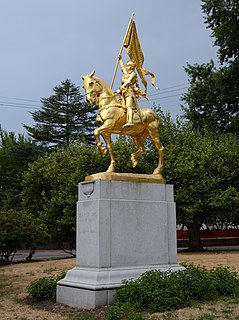
Laurelhurst is a neighborhood of vintage homes and undulating streets surrounding a park of the same name, straddling the NE and SE sections of Portland. Stone markers flank the entrances to the area. The center of the neighborhood, Coe Circle, contains a gilded equestrian statue of Joan of Arc, which is a World War I war memorial. The Laurelhurst Historic District was officially listed in the National Register of Historic Places In 2019.

The Ladd Carriage House is a building in downtown Portland, Oregon, at Broadway and Columbia. It is one of the few surviving buildings forming part of the former grand estates which once stood in the downtown core. It is listed on the National Register of Historic Places.

The U.S. Customhouse is a historic custom house in Portland in Multnomah County, Oregon. It was constructed to house offices of the United States Customs Service. It was built in 1898–1901 and is listed on the U.S. National Register of Historic Places. It is currently used as the Portland, Oregon location for WeWork, a coworking space provider.
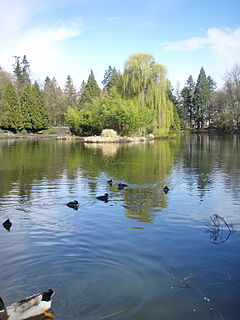
Laurelhurst Park is a city park in the neighborhood of Laurelhurst in Portland, Oregon. The 26.81-acre (10.85 ha) park was acquired in 1909 from the estate of former Portland mayor William S. Ladd. The City of Portland purchased the land in 1911, and the following year park superintendent Emanuel Mische designed the park in accordance with the Olmsted Plan.

The Jacob Kamm House, also called the Jacob Kamm Mansion, is a French Second Empire style mansion in Portland, Oregon, built in 1871. It was moved from its original location on SW 14th and Main to its current location in Goose Hollow in 1950 to make room for Lincoln High School's campus. It was purchased by preservationist Eric Ladd for $1,000 at auction and moved to its present location, along with two other houses Ladd was interested in preserving, at SW 20th and Jefferson, which was called "the colony."

The Gustave Bartman House in southeast Portland in the U.S. state of Oregon is a two-and-a-half-story dwelling listed on the National Register of Historic Places. A Queen Anne structure built in 1892, it was added to the register in 1989. Bartman, a contractor, may have built the house.

The Nettie Krouse Fourplex in southeast Portland in the U.S. state of Oregon is a 2.5-story multiple dwelling listed on the National Register of Historic Places. Built in the American Craftsman style in 1910, it was added to the register in 1989.
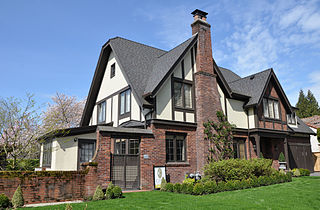
The James Hickey House is a house in the Eastmoreland neighborhood of southeast Portland, Oregon. The Tudor Revival style house was finished in 1925 and was added to the National Register of Historic Places in 1990. It was built by the architectural firm Lawrence & Holford and was one of architect Ellis Lawrence's designs for a building contractor named James Hickey. The house was built with the intention of being a model home in the Eastmoreland neighborhood.
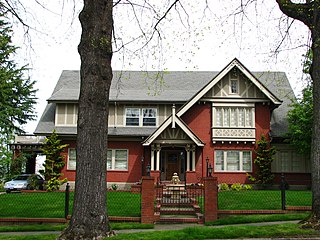
The Blaine Smith House in southeast Portland in the U.S. state of Oregon, is a two-story single dwelling listed on the National Register of Historic Places. Built in 1909 in an Arts and Crafts architectural style, it was added to the register in 1991.

The Paul C. Murphy House is a 2.5-story residence in southeast Portland, in the U.S. state of Oregon. Built in 1916 in the English Cottage style, it was added to the National Register of Historic Places in 1991.

The Leslie M. Scott House in southeast Portland in the U.S. state of Oregon is a 2.5-story dwelling listed on the National Register of Historic Places. A bungalow built in American Craftsman style in 1910, it was added to the register in 1989.

The United States National Bank Building in downtown Portland, Oregon, is listed on the National Register of Historic Places. Designed by famed Portland architect A. E. Doyle in a Roman classical style, the four-story building's first section, facing Sixth Avenue, was completed and opened in 1917. An extension westward to Broadway, approximately doubling its size, was constructed in 1925. Since then the building has occupied one-half of a city block. It features a four-story-high colonnade of Corinthian order columns at its eastern end, originally the principal façade, and extensive use of glazed terracotta. The interior is also decorated extensively with highly textured materials. The building was constructed for the United States National Bank of Portland (USNB), which ultimately became part of U.S. Bancorp, whose retail banking division operates as U.S. Bank. In 2020, more than 100 years after the building's opening, it continues to serve as the bank's main Portland branch.

The Italian Gardeners and Ranchers Association Market Building, also known as the Italian Market, in southeast Portland, Oregon in the U.S. is a two-story commercial structure listed on the National Register of Historic Places. Built of concrete in 1922, it was added to the register in 1989.

Portland Fire Station No. 23 in southeast Portland in the U.S. state of Oregon is a two-story structure listed on the National Register of Historic Places. Built in Italianate style in 1913, it was added to the register in 1989.

Bitar Mansion, also known as Harry A. Green House or the Harry A. and Ada Green House, is a mansion in the Laurelhurst neighborhood of Portland, Oregon, United States. The 12,000-square-foot (1,100 m2) and 17-room structure was designed by architect Herman Brookman and built in 1927 for $410,000, equivalent to $6.04 million today. The Mediterranean-style house contains a grand ballroom and many elaborate details. The mansion has views of the Tualatin Mountains and adjacent Laurelhurst Park.

The Capt. George Raabe House in southeast Portland in the U.S. state of Oregon is a 1.5-story dwelling listed on the National Register of Historic Places. Built in 1902, it was added to the register in 1989.

The George P. Lent Investment Properties, also known as Firehouse Row, in southeast Portland in the U.S. state of Oregon, consists of a group of five similar 1.5-story, single-family houses listed on the National Register of Historic Places. Built in 1893, the group was added to the register in 1989. The Queen Anne style houses are next to one another at the corner of Southeast 7th Avenue and Southeast Harrison Streets. They are commonly referred to as Firehouse Row because firemen from the adjacent Portland Fire Station No. 23 sometimes lived in them.
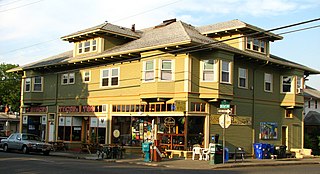
The Henry Kuehle Investment Property, also known as the Gottsacker Grocery Building, in southeast Portland in the U.S. state of Oregon is a two-story commercial building listed on the National Register of Historic Places. Built in Bungalow/Craftsman style in 1909, it was added to the register in 1989.

The Alfred Webb Investment Properties in southeast Portland in the U.S. state of Oregon consists of four Queen Anne cottages listed on the National Register of Historic Places. Built in 1891, they were added to the register in 1989.




















